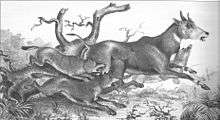Robert Armitage Sterndale
Robert Armitage Sterndale CMG (1839 – 3 October 1902) was a naturalist, artist, writer and statesman who worked in India before becoming governor general of St. Helena.[1][2][3]

Sterndale was born in 1839, the fourth son of Margaret née Craufuird (1806–1866) and William Handley Sterndale (1791–1866) from Ashford, Derbyshire who went to India to become an indigo planter in Tirhoot, Bihar. Robert studied privately before qualifying for the Indian Civil Service (ICS) and going to India in 1856 to work in the finance department. He volunteered with local regiments during the Indian Rebellion of 1857 and became a deputy collector in August 1859. He later became an assistant settlement officer and then in the finance departments at Nagpur, Calcutta and Punjab. He became Accountant General for Bombay in January 1884 and then at Madras in 1887.[4]
A keen sportsman and big-game hunter, he wrote several books on natural history including on the mammals of India. He was one of the first editors of the Journal of the Bombay Natural History Society. His work Seonee, or Camp Life on the Satpura Range published in 1877 influenced the work of Rudyard Kipling and inspired many scenes in the Jungle Book.[5] He also wrote for newspapers contributing to The Asian. An accomplished artist, he made pen sketches, water colours and oil paintings of natural history subjects and was a friend of the artist John Trivett Nettleship.[6] He illustrated two books of E. H. Aitken and contributed a few illustrations to the Lays of Hind by "Aliph Cheem" apart from his own books.[7][8] Sterndale worked in the Currency Department (starting as an assistant to the deputy commissioner of paper currency in 1868) at Calcutta and retired in 1890. In 1891, the congress of orientalists awarded him a medal of merit.[9] In 1894 he helped in the set up of a committee (other members included Robert G.W. Herbert, James Mackenzie, E. Field, Grant Blunt, J. C. Mellis[10]) in London to save St. Helena and set up a fish curing industry. In 1895 he was temporarily assigned to govern St. Helena during the absence of William Grey-Wilson and was posted as a Governor in 1897,[11] a position that was succeeded by Henry Lionel Galway in 1902. One of his brothers Handley Bathurst Sterndale (1829-1878) was an archaeologist who suggested connections between the monuments made by vanished Polynesian civilizations and relics in India, Britain and Central America.[12] His sister Agnes married Sir Cecil Beadon in 1860.[13]
Sterndale died of a heart attack at the St Ermin's Hotel in Westminster while home on sick leave from Saint Helena on 2 October 1902.[14] His wife Mary Catherine née Spitta (1845–1927) died at Southsea.[15] They had two daughters: Harriet Mary Sterndale (1873–?) who married Col Cecil Charles Palmer RA (1872–?); and Annette Mary Elinor Sterndale (1875–?) who married Major David Birdwood Thomson (1863–1930) a brother of Christopher Thomson, 1st Baron Thomson.
Publications
- [1884] Natural History of the Mammalia of India and Ceylon. Thacker, Spink, and Co., London and Calcutta.
- [1887] Seonee, or Camp Life on the Satpura Range. Thacker, Spink and Co., Calcutta and Simla.
- [1886] Denizens of the Jungle. Thacker, Spink and Co., Calcutta and Simla.
- [1879] The Afghan Knife. A Novel. Volume 1 Volume 2 Volume 3
References
- ↑ Jackson, E. L. (1903). "Robert Armitage Sterndate". St. Helena. p. 296.
- ↑ "Sterndale, Robert Armitage". Appletons' Cyclopaedia for 1902. NY: D. Appleton & Company. 1903. p. 517.
- ↑ "Obituary: Mr. R. A. Sterndale". The Geographical Journal. 20 (5): 550. 1902. JSTOR 1775127.
- ↑ "Death of the Governor of St. Helena". Derby Daily Telegraph. 7 October 1902 – via British Newspaper Archive.
- ↑ Crane, Ralph & Lisa Fletcher (2014). "Picturing the Indian tiger: Imperial iconography in the nineteenth century". Victorian Literature and Culture. 42 (3): 369–386. doi:10.1017/S1060150314000047.
- ↑ "Cronje's Gaoler. Author and Journalist.". Dundee Evening Telegraph. 29 March 1900. p. 4 – via British Newspaper Archive.
- ↑ "Aliph Cheem" (1905). Lays of Ind (11 ed.). London: W. Thacker and Co.
- ↑ "The Magazines. A Naturalist on the Prowl". Bath Chronicle and Weekly Gazette. 27 September 1894. p. 6 – via British Newspaper Archive.
- ↑ "Congressof Orientalists". Morning Post. 23 September 1891. p. 2 – via British Newspaper Archive.
- ↑ "A distressful island". Dover Express. 29 June 1894. p. 6 – via British Newspaper Archive.
- ↑ "Pall Mall Gazette Office". Pall Mall Gazette. March 3, 1897. p. 8 – via British Newspaper Archive.
- ↑ "Literary Jottings". Whitstable Times and Herne Bay Herald. 1 November 1890. p. 7 – via British Newspaper Archive.
- ↑ Buckland, C.E. (1901). Bengal under the Lieutenant-Governors. Volume 1. London: S.K. Lahiri & Co. p. 276.
- ↑ "[Untitled]". Hull Daily Mail. 8 October 1902. p. 5 – via British Newspaper Archive.
- ↑ "[Untitled]". Dundee Evening Telegraph. 10 November 1927. p. 7 – via British Newspaper Archive.
External links
- Works by Robert Armitage Sterndale at Project Gutenberg
- Works by or about Robert Armitage Sterndale at Internet Archive